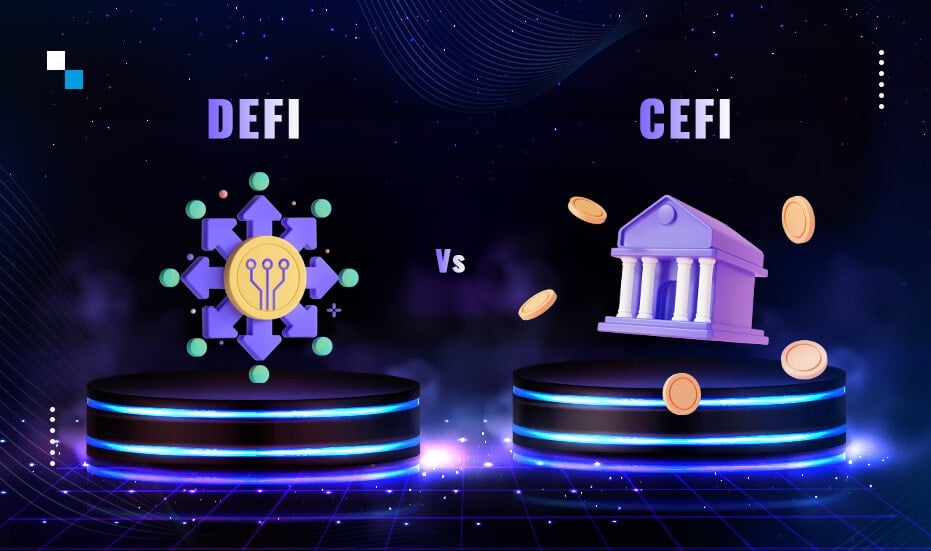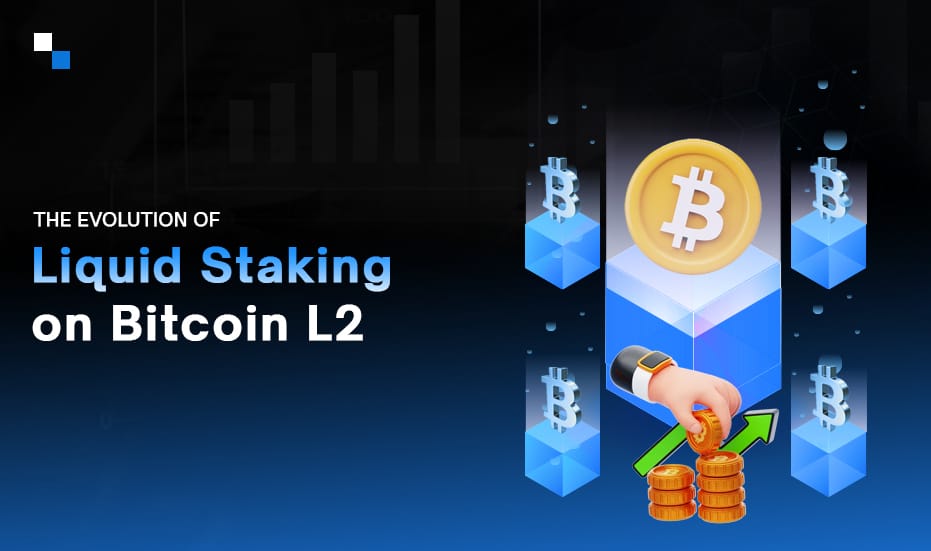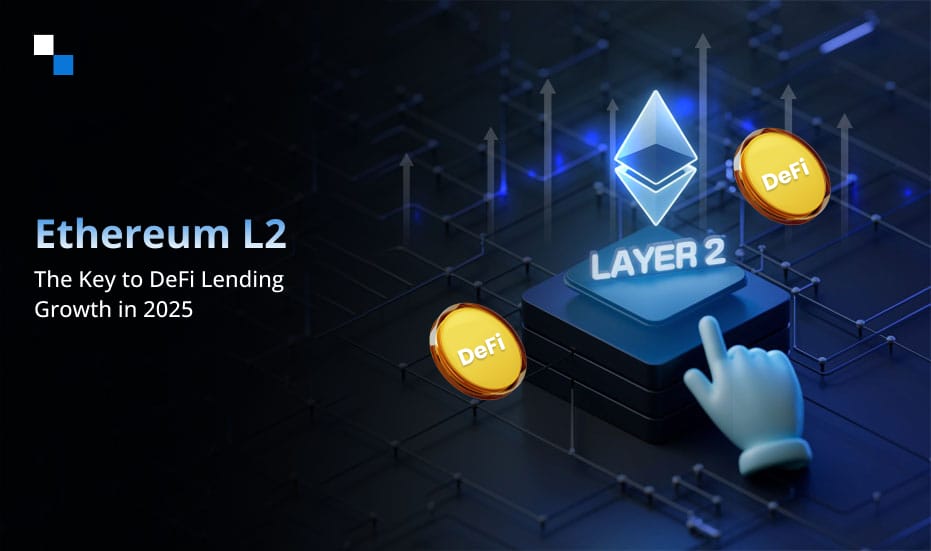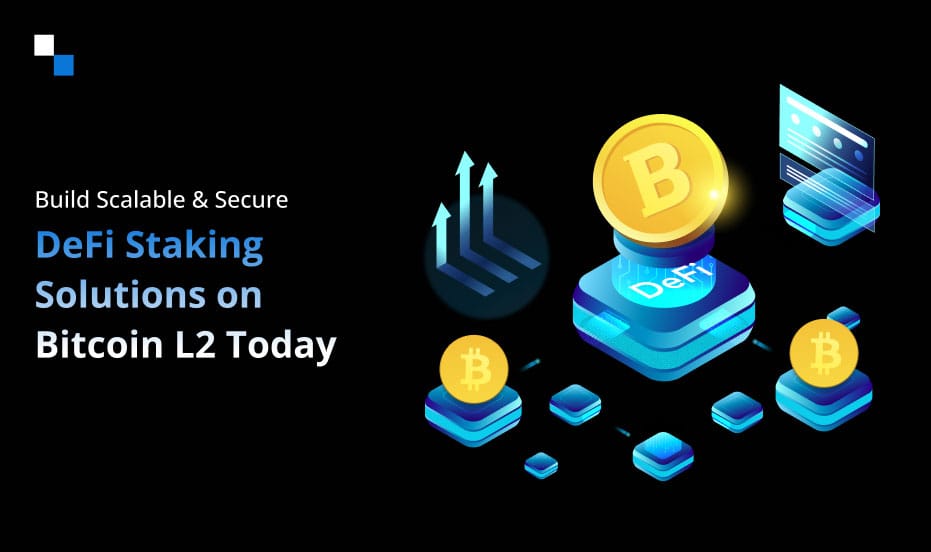
Driving the Business Success with Play-to-Earn NFT Game Development
May 26, 2023
Exploring the Potential of Web 3.0 Development: A Paradigm Shift in the Digital Landscape
May 30, 2023The world of finance has been undergoing a significant transformation in recent years, largely driven by technological advancements and the rise of cryptocurrencies. Two key concepts that have gained substantial attention are Decentralized Finance (DeFi) and Centralized Finance (CeFi). While both DeFi and CeFi aim to revolutionize the financial industry, they differ in their fundamental approaches and features. In this blog, we will explore the key features and differences between decentralized finance development and Centralized finance development.
What is DeFi?
Decentralized Finance, or DeFi, refers to a system of financial applications and platforms that are built on blockchain technology, typically utilizing smart contracts. Unlike traditional centralized financial systems, DeFi platforms are decentralized and operate without intermediaries, providing users with more control over their funds. DeFi applications encompass a wide range of services, including lending, borrowing, trading, insurance, and more. As of March 2023, the TVL in DeFi is US$75 billion.
Examples of DeFi:
- Aave: A decentralized lending and borrowing protocol.
- Compound: A decentralized lending and borrowing protocol.
- Uniswap: A decentralized exchange.
- SushiSwap: A decentralized exchange.
- MakerDAO: A decentralized stablecoin protocol.
- Lido: A decentralized staking service.
Key Features of DeFi
Here are some of the key features of DeFi:
Openness and Accessibility
DeFi platforms are generally accessible to anyone with an internet connection and compatible digital wallets. Users can participate in the ecosystem without going through the traditional banking system or meeting stringent eligibility criteria.
Decentralization
DeFi development solutions are built on blockchain networks, ensuring that the decision-making and operations are distributed across multiple nodes, making them resistant to censorship and single points of failure.
Interoperability
DeFi protocols are often designed to be interoperable, meaning they can interact with each other and share information seamlessly. This allows for the development of complex financial instruments and the creation of interconnected ecosystems.
Transparency
Since DeFi platforms are built on blockchain technology, all transactions and smart contract operations are recorded on a public ledger, providing transparency and auditability.
Programmability
DeFi development solutions utilize smart contracts, which are self-executing contracts with predefined rules and conditions. This programmability enables the automation of various financial processes, reducing the need for intermediaries and increasing efficiency.

What is CeFi?
Centralized Finance, or CeFi, represents the traditional financial system we are accustomed to, where financial activities are facilitated and controlled by centralized entities such as banks, brokers, and financial institutions. CeFi platforms act as intermediaries, holding custody of funds, facilitating transactions, and providing various financial services.
Examples of CeFi
- Binance: A cryptocurrency exchange
- Coinbase: A cryptocurrency exchange
- Kraken: A cryptocurrency exchange.
- Celsius Network: A cryptocurrency lending platform
- BlockFi: A cryptocurrency lending platform
Key Features of CeFi
Let’s see some of the key features of CeFi:
Trusted Third Parties
CeFi platforms rely on trusted intermediaries to manage and secure users’ funds. These intermediaries often undergo regulatory compliance and implement security measures to protect user assets.
Established Infrastructure
CeFi platforms benefit from well-established infrastructure and technologies, enabling fast transaction processing and high-volume trading.
Customer Support
CeFi platforms typically offer customer support services, allowing users to seek assistance and resolve issues through dedicated support channels.
Regulatory Compliance
CeFi platforms operate under regulatory frameworks, ensuring compliance with legal and financial requirements. These regulations aim to protect users and prevent fraudulent activities.
Fiat Integration
Unlike DeFi development solutions, CeFi platforms often provide seamless integration with traditional banking systems, allowing users to deposit and withdraw fiat currencies.
Differences Between DeFi and CeFi
DeFi and CeFi are different from each other. Below are some of the key differences between DeFi and CeFi:
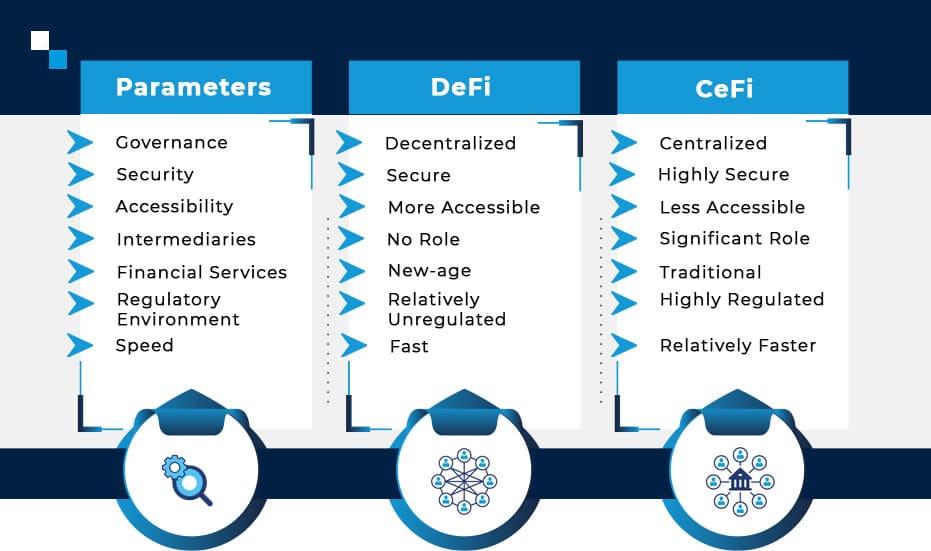
Governance
In DeFi, the decision-making process is decentralized, with users participating in protocol governance through voting or staking mechanisms. In CeFi, decisions are made by centralized entities, and users have limited influence over the platform’s operations.
Security
DeFi development services face challenges, as they are susceptible to smart contract vulnerabilities and hacking attempts. On the other hand, CeFi platforms typically employ centralized security measures and custodial services, which can be both an advantage and a single point of failure.
Accessibility
DeFi platforms are generally more accessible since they are open to anyone with an internet connection and compatible digital wallets. There are no stringent eligibility requirements, and users can participate in the ecosystem from anywhere in the world. CeFi platforms, on the other hand, may have geographical restrictions, KYC (Know Your Customer) procedures, and other eligibility criteria that users must meet before accessing their services.
Intermediaries and Control
DeFi eliminates the need for intermediaries by allowing users to have full control over their funds. Users interact directly with the smart contracts, and transactions occur peer-to-peer without relying on centralized entities. In CeFi, intermediaries such as banks, exchanges, and brokers play a crucial role in facilitating financial transactions. While this can provide a sense of security and customer support, it also means that users need to trust these intermediaries with the custody and management of their assets.
Financial Services Offered
DeFi platforms offer a wide range of financial services, including lending, borrowing, decentralized exchanges (DEXs), yield farming, liquidity provision, and more. These services often operate on open protocols and can be customized and combined to create innovative financial products. Due to numerous services, DeFi development services are in huge demand. CeFi platforms, on the other hand, typically focus on more traditional financial services such as banking, trading on centralized exchanges (CEXs), and investment products. While CeFi platforms may offer a broader array of investment options, DeFi platforms are known for their flexibility and the ability to tailor financial services to individual needs.
Regulatory Environment
DeFi operates in a relatively unregulated space, as it was born out of the decentralized nature of blockchain technology. While this provides users with freedom and autonomy, it also means that there may be fewer legal protections and recourse in case of fraud or disputes. CeFi platforms, on the contrary, operate under established regulatory frameworks and compliance requirements. This can provide users with a sense of security and legal protection, but it also introduces additional restrictions and compliance costs.
Scalability and Speed
CeFi platforms often benefit from established infrastructure and centralized systems, allowing for fast transaction processing and high-volume trading. They can handle a large number of transactions simultaneously, which is crucial for users who require quick execution and liquidity. DeFi platforms, especially those built on popular blockchains like Ethereum, have faced scalability challenges due to network congestion and limitations. However, various scaling solutions and layer-two protocols are being developed to address these issues and improve scalability.

Conclusion
DeFi and CeFi represent two distinct approaches to finance, each with its own set of features and differences. DeFi platforms offer openness, decentralization, and programmability, allowing users to have more control over their funds and participate in a wide range of financial services. CeFi platforms, on the other hand, provide established infrastructure, regulatory compliance, and trusted intermediaries, offering users a sense of security and customer support. Both DeFi and CeFi have their strengths and weaknesses, and their coexistence allows users to choose the financial ecosystem that aligns with their preferences and needs. Looking for a DeFi development company? Get in touch today!
